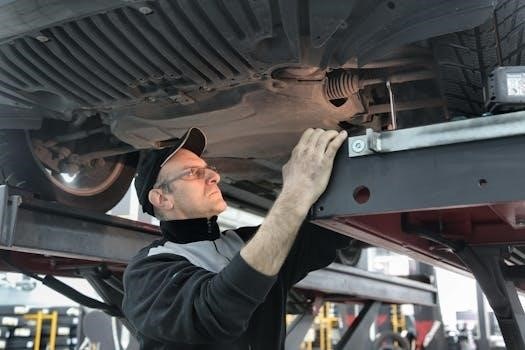What is a Manual Scissor Lift?
A manual scissor lift is a type of lifting machine, primarily used for handling smaller items within a limited range. Unlike powered lifts, it relies on human force, often through a foot pump, to elevate the platform. These lifts are ideal for light-duty tasks.
Definition and Basic Function
A manual scissor lift is a mechanical device designed to lift and lower materials using a scissor-like mechanism. It operates without the need for electric or hydraulic power, relying instead on human force, typically through a foot-operated hydraulic pump or a hand crank. The basic function of a manual scissor lift is to provide a stable and adjustable platform for lifting, positioning, and transporting lighter loads within a limited vertical range. This type of lift is commonly used in various settings where portability and ease of use are more important than high lifting capacity or speed. It’s designed to eliminate manual lifting, bending, and twisting, improving ergonomics and reducing the risk of injury to workers. The manual scissor lift has a simple, robust construction that allows for use in environments where power is not available or is not desirable. It is a versatile solution for tasks such as loading and unloading, material handling, and assembly line operations, often used in warehouses, manufacturing facilities, and retail spaces.
Primary Applications of Manual Scissor Lifts
Manual scissor lifts are primarily utilized in scenarios requiring the lifting and positioning of lighter loads within a relatively small vertical range. They are particularly useful in manufacturing facilities for moving components between workstations, enhancing ergonomics by reducing the need for manual lifting and awkward postures. In warehouses, these lifts aid in order picking, stocking shelves, and general material handling tasks, where items are not excessively heavy but need to be elevated for easy access. Retail environments also benefit from manual scissor lifts, as they can be employed for restocking shelves, setting up displays, and moving goods from storage to the sales floor. Additionally, these lifts find application in maintenance tasks where tools and equipment need to be raised to working heights. The portability and ease of use make manual scissor lifts suitable for areas where power sources are not readily accessible or where frequent movement is required. Their simple design and lack of electrical components make them a reliable choice for diverse, light-duty applications that require a safe and ergonomic lifting solution.

Types of Scissor Lifts
Scissor lifts are diverse, categorized by power source and application. Common types include hydraulic, electric, diesel, and rough terrain models. These lifts vary in capacity, size, and suitability for different work environments, offering solutions for varied lifting needs.
Classification of Scissor Lifts
Scissor lifts are broadly classified based on their mobility and power source. They can be stationary or mobile, with mobile units further divided into towable, self-propelled, and manual options. Within these categories, you’ll find variations like narrow scissor lifts designed for tight spaces, diesel-powered models for heavy-duty outdoor work, and battery-powered electric lifts suitable for indoor use. Manual scissor lifts represent a distinct class, relying on human power for operation. The classification also considers structural varieties, including scissor cylinder, aluminum alloy, crank, and chain types. Furthermore, scissor lifts can be categorized by their intended use, such as personnel lifts or material handling lifts. These classifications help users select the most appropriate lift for their specific tasks, considering factors like load capacity, operating environment, and power requirements. Understanding these distinctions is essential when choosing the right scissor lift for any given project. The classification ensures that the chosen equipment is safe, efficient, and suitable for the job at hand. This variety allows for a wide range of applications across different industries and work scenarios.

Hydraulic Scissor Lifts
Hydraulic scissor lifts utilize a hydraulic system to power their lifting mechanism. This system, typically involving cylinders filled with hydraulic fluid, provides a reliable and robust means of raising and lowering the platform. These lifts can be either hand-operated or engine-driven, offering flexibility for various applications. In hand-operated hydraulic lifts, a manual pump pressurizes the fluid, while engine-driven models use a motor to power the hydraulic pump. Hydraulic scissor lifts are known for their versatility and are widely used in construction, warehousing, and manufacturing. The hydraulic system allows for smooth and controlled movement, making them suitable for both light and heavy-duty lifting tasks. While some manual scissor lifts also use hydraulics, it’s important to distinguish between manual hydraulic lifts and those that use a separate power source to activate the hydraulic system. The hydraulic mechanism ensures that the platform remains stable during operation, contributing to the safety and efficiency of the lifting process. These lifts often have safety features like pressure relief valves to prevent overloading and ensure reliable performance. The use of hydraulic power offers a powerful lifting solution for a wide range of needs.
Electric Scissor Lifts
Electric scissor lifts are powered by electricity, typically using a rechargeable battery, which makes them ideal for indoor applications where noise and emissions need to be minimized. These lifts offer a quiet and emission-free operation, making them suitable for use in warehouses, retail spaces, and other enclosed environments. They are a popular choice for tasks such as ceiling construction, sign hanging, and general maintenance. Unlike manual or diesel-powered options, electric scissor lifts provide effortless power lifting, often with fast load elevation capabilities. The electric motor powers a hydraulic pump, which raises and lowers the platform smoothly. Electric scissor lifts are available in various sizes and lifting capacities to accommodate different job requirements. Many models also include features like non-marking tires to prevent damage to indoor flooring. They are designed for ease of use and often come with intuitive controls. Some electric scissor lifts also have enhanced safety features such as automatic braking systems and platform load sensors. The rechargeable battery allows for extended periods of use, and many models have built-in chargers for convenience. These lifts are a practical and efficient option for many industries.
Diesel-Powered Scissor Lifts
Diesel-powered scissor lifts are designed for heavy-duty outdoor applications, where their robust power and capabilities are essential. These lifts are typically used on construction sites and other rugged environments that demand high lifting capacities and the ability to handle rough terrain. Unlike electric models, diesel scissor lifts are powered by a combustion engine, providing the strength needed for demanding tasks. The engine drives a hydraulic system, which elevates the platform with considerable force. Due to their power source, these lifts are not suitable for indoor use because they produce emissions. Diesel scissor lifts are built to withstand harsh conditions and are often equipped with features like durable tires, all-wheel drive, and enhanced stability. They are available in a variety of sizes, from smaller models for lighter loads to larger ones capable of lifting significant weight to great heights. Diesel lifts are known for their reliability and ability to operate for extended periods without needing to recharge. This makes them a practical option for remote locations or where power is not easily accessible. While they require regular maintenance, the power and versatility of diesel-powered scissor lifts make them a valuable tool in many industries.
Rough Terrain Scissor Lifts

Rough terrain scissor lifts are specifically engineered to operate effectively on uneven and challenging outdoor surfaces. These lifts are commonly employed in construction sites, landscaping projects, and other environments where standard scissor lifts cannot perform. What distinguishes rough terrain models is their reinforced chassis, robust tires, and four-wheel drive capability, enabling them to navigate slopes, mud, and other obstacles. They are designed to provide stability and safety when working at heights on unstable ground. Unlike standard electric or hydraulic lifts, rough terrain scissor lifts often use diesel or hybrid engines, which provide the extra power needed to handle the difficult conditions. The platforms of these lifts are also designed to ensure safe and stable operation, even on uneven surfaces. Some rough terrain models are equipped with automatic leveling systems, further enhancing their stability; These lifts are constructed to withstand harsh environments and heavy use, making them a reliable choice for demanding outdoor projects. Despite their robust construction, they are designed to be user-friendly, featuring intuitive controls and safety features. Rough terrain scissor lifts are an essential component of many construction and maintenance operations, providing a safe and efficient means of accessing work areas in challenging environments.

Manual Scissor Lift Varieties
Manual scissor lifts come in several varieties, including mobile semi-electric and manual mobile dual scissor lift tables. These designs cater to diverse needs, offering flexibility in material handling and ergonomic solutions for various workplace demands. Each type is tailored for specific tasks.
Mobile Semi-Electric Scissor Lifts
Mobile semi-electric scissor lifts represent a hybrid approach to material handling, combining manual operation with electric assistance. These lifts are designed for frequent use, providing the flexibility of manual positioning with the added benefit of powered elevation. The manual aspect allows for easy movement around a workspace, while the electric component facilitates effortless raising and lowering of the platform, reducing physical strain on operators. This dual functionality makes them suitable for tasks where both maneuverability and lifting power are essential. Often equipped with rechargeable batteries, these lifts offer a balance between convenience and efficiency, making them a practical choice for various applications. They are commonly used in environments where a fully manual lift might be too laborious, but a fully electric lift may not be necessary or practical. Their design incorporates safety features, ensuring stable and controlled movement. The semi-electric nature also allows for quieter operation compared to fully electric models, which can be beneficial in noise-sensitive environments. Overall, they offer a versatile solution for lifting and positioning materials in diverse settings. They represent a pragmatic blend of manual and electric technology.
Manual Mobile Dual Scissor Lift Tables
Manual mobile dual scissor lift tables, often abbreviated as MMLTD, are specifically designed to be portable and ergonomic solutions for a wide variety of workplace requirements. These tables feature a dual scissor mechanism, enabling them to achieve higher lift heights compared to single scissor models. The manual operation ensures they can be used in areas where power is not readily available, providing flexibility and convenience. Their mobile nature allows for easy relocation within a workspace, making them ideal for dynamic environments where materials need to be moved and positioned frequently. By reducing the need for manual lifting, bending, and straining, these tables significantly improve workplace safety and reduce the risk of injury. They are particularly useful in applications where precise positioning of materials is required. The robust construction of these tables ensures they can handle a range of load capacities, making them suitable for diverse industrial settings. The manual operation also provides the user with a high level of control over the lifting process. These tables serve as a versatile ergonomic tool, promoting efficiency and safety in material handling. They are designed for ease of use, and their portability enhances their practicality in diverse operational scenarios. The dual scissor design enables them to reach greater heights.
